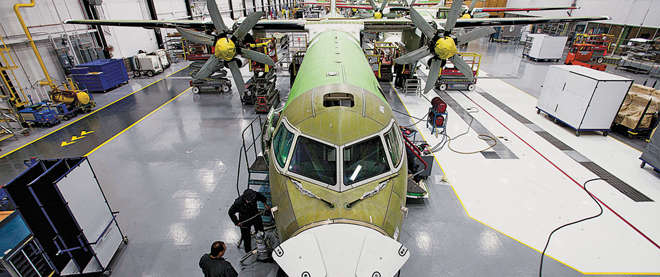A grant dump that smothers innovation
What’s the result of the hundreds of billions of dollars the government spends on innovation? Bupkes.
Share

 For more than 30 years, people have been sounding the alarm at Canada’s disturbing decline in relative productivity, at our appalling lack of innovation, at a record of investment in R & D that can only be described as depraved. And for more than 30 years, governments have been doing something about it.
For more than 30 years, people have been sounding the alarm at Canada’s disturbing decline in relative productivity, at our appalling lack of innovation, at a record of investment in R & D that can only be described as depraved. And for more than 30 years, governments have been doing something about it.
Have they ever. The federal government helps industry to innovate to the tune of $5 billion every year, delivered through more than 60 programs spread across 17 different agencies: the Industrial Research Assistance Program (IRAP), the Business Development Program (BDP), the Technology Demonstration Program (TDP), the Strategic Aerospace and Defence Initiative (SADI), the Automotive Innovation Fund (AIF), the Strategic Network Grants (SNG), the Centres of Excellence for Commercialization and Research (CECR), the Networks of Centres of Excellence (NCE), the Business-Led Networks of Centres of Excellence (BL-NCE), the Centres for Strategic Research on Innovative Technology Networks (okay, I made that one up), on and acronymically on. And that’s just the feds. There are hundreds more innovation programs at the provincial level, and who knows how many others lurking among the nation’s municipalities and universities. The agricultural sector in Ontario alone requires no fewer than 45 such programs, courtesy of seven federal and provincial departments. All on top of the flagship federal tax incentive, the Scientific Research and Experimental Development (SR&ED) tax credit. Altogether, Canada is reckoned to provide among the most generous systems of R & D support in the world, behind only Spain and France.
And the result of all these hundreds of billions of dollars in support for innovation, this Manhattan Project of industrial research? Bupkes. From 1985 through 2006, Canada’s productivity growth ranked 15th out of 18 countries at comparable levels of development. Business spending on R & D not only has failed to keep up with our international rivals, but has actually been falling for the past decade.
Not only have all of these programs not helped the cause, they seem actively to be retarding it. So many and confusing are the different eligibility conditions and reporting requirements that many firms have taken to hiring third-party consultants to help them through the process. Others have succeeded at “stacking” grants from different agencies and levels of government, enough in some cases to cover more than 100 per cent of the cost of whatever project they originally had in mind. With all of this grantrepreneurship going on, it seems there was little time left for innovation.
But never fear. A raft of new reports have appeared suggesting how we can take these failed and unworkable policies and . . . make them work. From the Independent Panel on Federal Support for Research and Development, headed by businessman Tom Jenkins, a recommendation to consolidate multiple programs under a single Industrial Research and Innovation Council (IRIC). (Also: “engage in dialogue with the provinces.”) From the Mowat Centre, a proposal to scrap tax incentives in favour of “strategic public investments,” which after all “have the advantage of being more strategic.”
We clearly need to disentangle a few concepts. There is a tendency to treat innovation as if it were a piece of industrial machinery in itself: you inject a certain amount of government funding at one end, you get a certain amount of R & D at the other, and you’re done. Not so. While you can find, just, a correlation between Canada’s heroic levels of tax assistance for R & D and actual spending on R & D, there is very little connection between aggregate spending on R & D and innovation, still less with higher output. Some of our splashiest R & D spenders, such as the auto and aerospace industries, are among the biggest sinkholes in the economy.
We begin to be on firmer ground if we understand innovation less as a scientific process, and more as an economic one. As a rather better report by the Council of Canadian Academies puts it, innovation is simply “new or better ways of doing valued things.” It doesn’t typically take the form of the breakthrough technology or gee-whiz invention. It’s doing hundreds of little things better, at every stage of production, often by incorporating existing technologies.
How do we get businesses to do more of that? It’s not actually all that complicated. Businesses will make the needed changes, take the needed risks, incur the needed expenses, if you do two things: a) let them, and b) force them. By letting them, I mean reducing barriers to investment. Chief among these, you will not be surprised to hear, are marginal tax rates. As another recent report, this one for the C. D. Howe Institute, observes, instead of stuffing firms with subsidies to innovate, governments would do better simply to refrain from confiscating so much of the returns when they do.
And the “force them” part? Competition. Competition, competition, competition. What comes out in all of the literature on productivity is the critical importance of “competitive intensity” in creating the incentive for businesses to innovate: or rather, in instilling the fear that the other guy will eat their lunch if they don’t. It’s when managers lie awake at night thinking of all those “little things” that much innovation occurs.
As documented in yet another expert report, from the federal Competition Policy Review Panel headed by former BCE chairman Red Wilson, too few of our managers have to do that, protected as they are from competition by foreign investment controls or domestic regulatory regimes. You want more innovation? Implement the Wilson report.